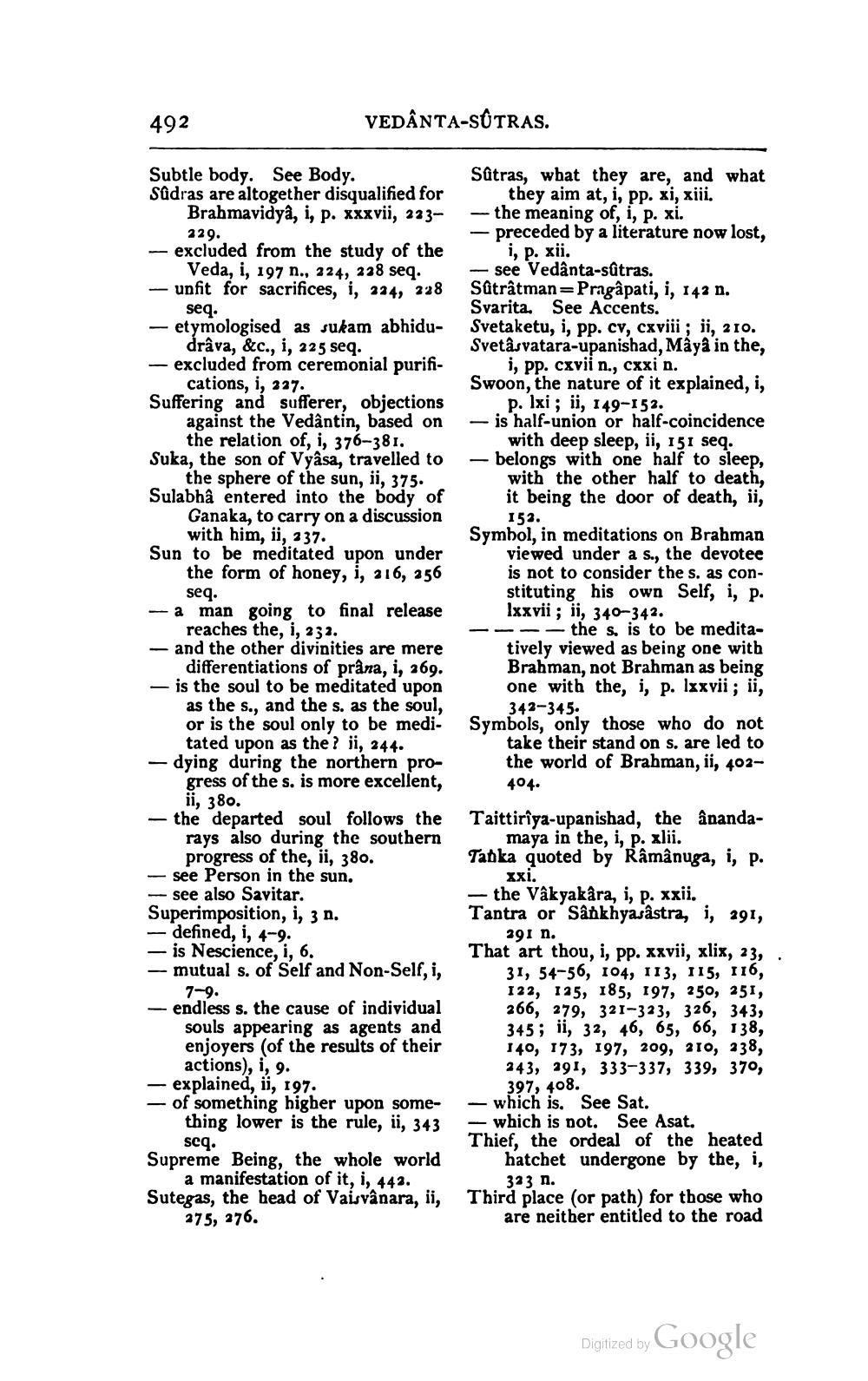________________
492
VEDÂNTA-SÛTRAS.
Subtle body. See Body. Sûdras are altogether disqualified for
Brahmavidya, i, p. xxxvii, 223-
229. - excluded from the study of the
Veda, i, 197 n., 224, 228 seq. - unfit for sacrifices, i, 224, 228
seq. - etymologised as sukam abhidu
drâva, &c., i, 225 seq. - excluded from ceremonial purifi
cations, i, 227. Suffering and sufferer, objections
against the Vedantin, based on
the relation of, i, 376-381. Suka, the son of Vyâsa, travelled to
the sphere of the sun, ii, 375. Sulabhâ entered into the body of
Ganaka, to carry on a discussion
with him, ii, 237. Sun to be meditated upon under
the form of honey, i, 216, 256
seg. - a man going to final release
reaches the, i, 232. - and the other divinities are mere
differentiations of prâna, i, 269. is the soul to be meditated upon as the s., and the s. as the soul, or is the soul only to be medi-
tated upon as the? ii, 244. - dying during the northern pro
gress of the s. is more excellent,
ii, 380. - the departed soul follows the
rays also during the southern
progress of the, ii, 380. - see Person in the sun, - see also Savitar. Superimposition, i, 3 n. - defined, i, 4-9. – is Nescience, i, 6. - mutual s. of Self and Non-Self, i,
7-9. - endless s. the cause of individual
souls appearing as agents and enjoyers (of the results of their
actions), i, 9. - explained, ii, 197. - of something higher upon some
thing lower is the rule, ii, 343
seq. Supreme Being, the whole world
a manifestation of it, i, 443. Sutegas, the head of Vaisvânara, ii,
275, 276.
Sätras, what they are, and what
they aim at, i, pp. xi, xiii. - the meaning of, i, p. xi. – preceded by a literature now lost,
i, p. xii. - see Vedânta-sâtras. Sütrâtman=Pragâpati, i, 142 n. Svarita. See Accents. Svetaketu, i, pp. cv, cxviii; ii, 210. Svetâsvatara-upanishad, Mâyâ in the,
i, pp. cxvii n., cxxi n. Swoon, the nature of it explained, i,
p. lxi; ii, 149-152. – is half-union or half-coincidence
with deep sleep, ii, 151 seq. - belongs with one half to sleep,
with the other half to death, it being the door of death, ii,
152. Symbol, in meditations on Brahman
viewed under a s., the devotee is not to consider the s. as constituting his own Self, i, p. Ixxvii; ii, 340–342. --- the s, is to be meditatively viewed as being one with Brahman, not Brahman as being one with the, i, p. lxxvii; ii,
342-345. Symbols, only those who do not
take their stand on s. are led to the world of Brahman, ii, 403–
404. Taittiriya-upanishad, the ananda
maya in the, i, p. xlii. Tanka quoted by Râmânuga, i, p.
xxi. - the Vâk yakâra, i, p. xxii. Tantra or Sankhyasastra, i, 291,
291 n. That art thou, i, pp. xxvii, xlix, 23, .
31, 54-56, 104, 113, 115, 116, 122, 125, 185, 197, 250, 251, 266, 279, 321-323, 326, 343, 345; ii, 32, 46, 65, 66, 138, 140, 173, 197, 209, 210, 238, 243, 291, 333-337, 339, 370,
397, 408. — which is. See Sat. - which is not. See Asat. Thief, the ordeal of the heated
hatchet undergone by the, i,
323 n. Third place (or path) for those who
are neither entitled to the road
Digized by Google




